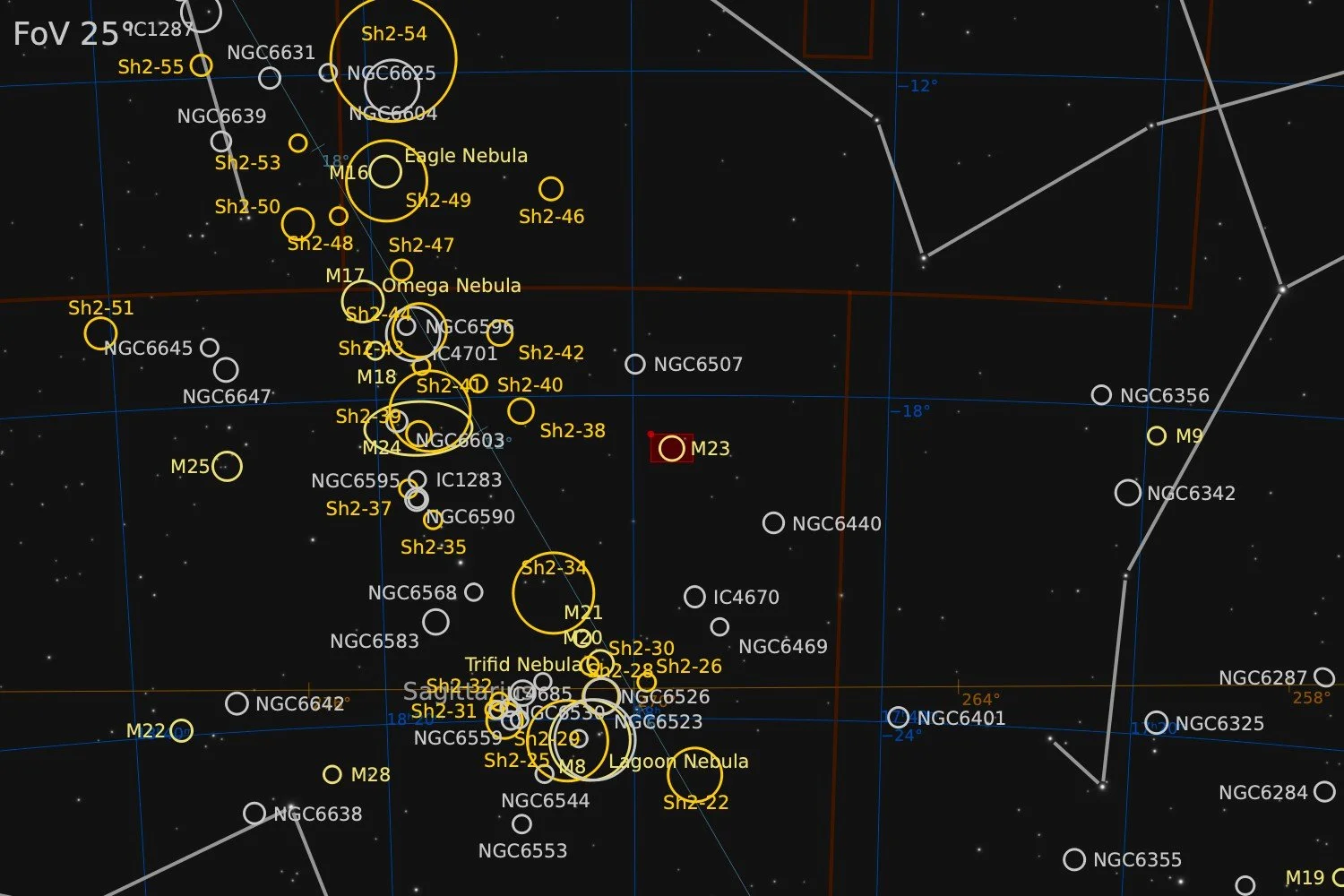M23
NGC 6494
47’ x 31’ | 0.3”/px | 9444 × 6245 px | full resolution
Sagittarius
RA 17h 56m Dec -18° 58’ | 0°



Messier 23 is an open cluster of stars in the northwest of the constellation Sagittarius. It was discovered by Charles Messier in 1764. It is in front of "an extensive gas and dust network", which there may be no inter-association. It is within 5° the sun's position (namely in mid-December) so can be occulted by the moon. The cluster is centered about 2,050 light years away. Estimates for the number of its members range from 169 up to 414, with a directly-counted mass of 1,206 sun masses. The cluster is around 330 million years old with a near-solar metallicity of [Fe/H] = −0.04. The brightest component (lucida) is of magnitude 9.3. Five of the cluster members are candidate red giants, while orange variable VV Sgr in the far south, is a candidate asymptotic giant branch star.
source: Wikipedia
Data Acquisition
Data was collected over 4 nights during mid June 2025, using a 14” reflector telescope with full-frame camera at the remote observatory in Spain. Data was gathered using standard RGB filters. As the data was collected under mostly full moon conditions, it was decided to not collect luminance data. Also, because the nature of an open cluster is just a collection of stars, with no further structural elements, a relatively short overall exposure seemed sufficient. A total of approximately 6 hours of data was finally combined to create the final image.
Location Remote hosting facility IC Astronomy in Oria, Spain (37°N 2°W)
Sessions
Frames
Equipment
Telescope
Mount
Camera
Filters
Guiding
Accessoires
Software
Planewave CDK14 (2563mm @ f/7.2), Optec Gemini Rotating focuser
10Micron GM2000HPS, custom pier
Moravian C3-61000 Pro (full frame), cooled to -10 ºC
Chroma 2” RGB unmounted, Moravian filterwheel L, 7-position
Unguided
Compulab Tensor I-22, Dragonfly, Pegasus Ultimate Powerbox v2
Voyager Advanced, Viking, Mountwizzard4, Astroplanner, PixInsight 1.9.3
Processing
All processing was done in Pixsinsight unless stated otherwise. Default features were enhanced using scripts and tools from RC-Astro, SetiAstro, GraXpert, CosmicPhotons and others. Images were calibrated using 50 Darks, 50 Flats, and 50 Flat-Darks, registered and integrated using WeightedBatchPreProcessing (WBPP). The processing workflow diagram below outlines the steps taken to create the final image.
No luminance data was collected, because of the full moon conditions and the relatively simple structure of an open star cluster. For this reason a manual stretching approach was applied. The first stretch was with ArcsinhStretch, with highlight protection on to not blow out the bright stars. This caused a very nice stretch with very natural looking stars. No blown out centers, no hard edges anywhere, etc. Just a mild touch up with HistogramTransformation and added brightness and saturation were enough to get close to the final image.
Some of the bright stars had a bit of a green/magenta hue on them. Probably the result of the full moon conditions. The greens were removed using SCNR early on. Later magenta was removed using SCNR on an inverted image. The effect of this later treatment was that the background stars turned a little bit more yellow-ish. This was corrected again using the hue curve in CurvesTransformation.
The full processing followed a workflow as is shown below.
Processing workflow (click to enlarge)
This image has been published on Astrobin.
